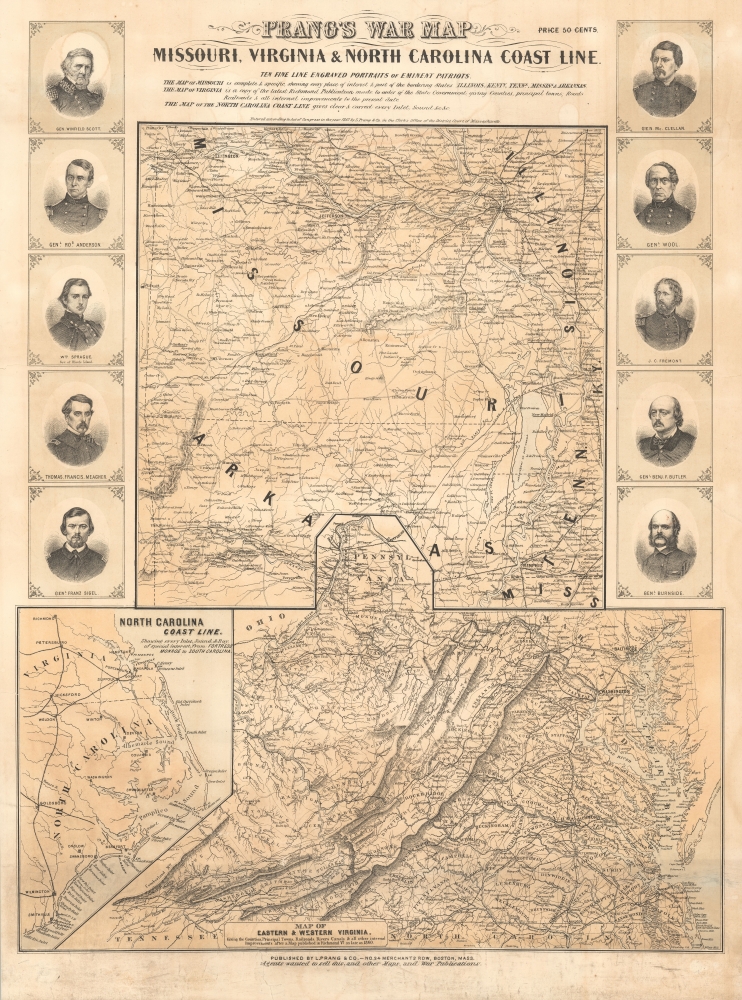This item has been sold, but you can get on the Waitlist to be notified if another example becomes available, or purchase a digital scan.
1861 Prang's Civil War Broadside Map of Missouri, Virginia, North Carolina
CivilWarMap-prang-1861
Title
1861 (dated) 27.5 x 20.5 in (69.85 x 52.07 cm) 1 : 1550000
Description
A Closer Look
This sheet contains three maps, representing the main theaters of war at the start of the conflict: the Carolinas, where open hostilities began at Fort Sumter; Missouri, which had seen growing tensions between abolitionists and secessionists for several years; and Virginia, the presumed main theater of land battles given the close proximity of Washington D.C. and Richmond, the capital of the Confederacy.The underlined names of towns and cities in Southern Missouri likely refer to engagements in the early months of the war. These battles were generally on a small scale, to the extent that not all have been registered by historians as proper battles, and often included irregular militia and volunteer forces. Several important battles occurred at and around Springfield, Missouri, a relatively large town of considerable strategic importance. After falling into rebel hands, Union forces under Charles Zagonyi recaptured the city on October 25 following a stunning charge against a much larger Confederate force.
Portraits of Union Generals
The map of Missouri is flanked by the portraits of leading Union generals at the start of the conflict. For most of the war, the Union army was led by inept generals, many of whom were political appointees with no military experience chosen to maintain the delicate coalition supporting the Union war effort. Lincoln was especially anxious to keep war-wary Democrats committed to the Union cause. He similarly appointed Franz Sigel and Thomas Francis Meagher, respectively, to lead German and Irish immigrants serving in the Union Army primarily for their political stature rather than military prowess.Politician-generals and professional military men were not mutually exclusive categories, however, as some politicians such as Ambrose Burnside and John C. Frémont had extensive previous military experience. Though valued highly by Lincoln, Frémont's tendency to act independently, accusations of corruption, and an unsanctioned emancipation edict that presaged the Emancipation Proclamation but alienated many fence-sitters in the border states, led to his dismissal as commander of the Department of the West. For his part, Burnside was competent enough commanding smaller units, but fared poorly when tasked with leading corps and armies; his brief command of the Army of the Potomac is remembered for the disastrous Union loss at Fredericksburg, one of the most lopsided battles of the war.
The two most prominent and capable commanders at this time were Winfield Scott and George McClellan. Scott was among the most seasoned and well-known military figures in the country at the time but was advanced in age and incapable of field command. He is best remembered for developing the 'Anaconda Plan' strategy to blockade the Confederacy on all sides and seize the Mississippi River to divide the core states of the Confederacy from supplies further west. McClellan, by contrast, was young and seen as a wunderkind of military science. However, his plodding, cautious style, pompous personality, and relatively sympathetic stance towards the Confederacy grated on others, especially President Lincoln (McClellan ran unsuccessfully against Lincoln for President in 1864). The fact that Scott and McClellan argued bitterly and distrusted each other did not help the Union cause.
As a whole, these Union generals have been judged harshly by history, deemed to have prioritized their vanity and careers over the lives of their soldiers or the interests of the country. All had retired, been demoted, or resigned by the end of the war. It was only in the middle to latter stages of the war that a group of capable commanders emerged, namely Ulysses S. Grant, William Tecumseh Sherman, and Philip Sheridan, that were able to combine effective strategy with the Union's advantage in manpower and industrial output to gain a complete victory over the Confederacy.
Publication History and Census
This map was published by Louis Prang and Co. in 1861. Assuming the underlined names of towns and cities refer to military actions there, the inclusion of Springfield, in addition to the reference to 'Western Virginia' rather than the later state, suggest a date late in the year. At the same time, the portrait of Scott, who retired on November 1, implies an earlier date. Therefore, the map was likely finalized in late October 1861. It is only listed among the holdings of the British Library and has no known history on the market.Cartographer
Louis Prang (March 12, 1824 - September 14, 1909) was a Boston based publisher of lithographs and chromolithographs active in the latter half of the 19th century. Prang was born in Breslau Germany where he studied printmaking and engraving from his father, a noted master of the calico process. Around 1850, Prang immigrated to the United States fearing political persecution in Germany after the failed Springtime of the Peoples Revolution, making him a 48er. In the United States, Prang partnered with another German Printmaker, Julius Mayer, establishing the short-lived Prang & Mayer firm. Ten years later, in 1860, Prang started his own chromolithography firm, L. Prang & Co. Prang quickly established himself as a publisher of post cards and other small prints, which were popular as gifts and collectibles. He was especially successful with mass-produced overviews of major battles in the U.S. Civil War, and his 'War Telegram Marking Map' was memorable for being sold with colored pencils, allowing buyers to track the movement of armies over time. Many consider him to be the "Father of the American Christmas Card". Prang also issued larger format chromolithographs of popular art and even printed his own magazine to the effect Prang's Chromo: A Journal of Popular Art. Through his magazines and limited edition printings, Prang was influential in establishing the popularity of the chromolithographic process in America. More by this mapmaker...

